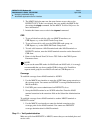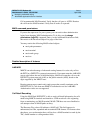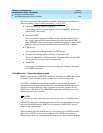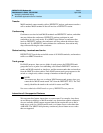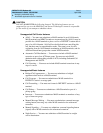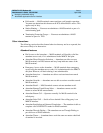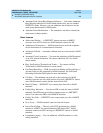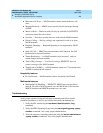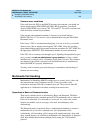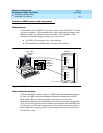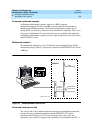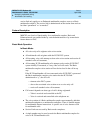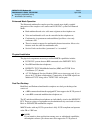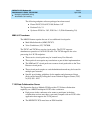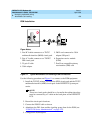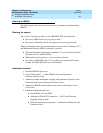
DEFINITY ECS Release 8.2
Administrator’s Guide
555-233-506
Issue 1
April 2000
Managing multimedia calling
230Multimedia Call Handling
9
Common error conditions
If the cable from the ECS to the MMCX becomes disconnected, you should see
alarms raised against ISDN-SGRP and UDS1-BD. In particular, you should
observe ISDN-SGRP errors such as 769, 1793, and 257. To resolve, reconnect the
cable and follow normal test procedures.
If the far-end path termination number is incorrect, you should observe
MASI-PTH error 513. To resolve, correct administration using the MASI Path
Parameters form.
If the Layer 3 TSC is not administered properly or is out of service, you should
observe errors (but no alarms) raised against TSC-ADM. Verify the signaling
group administration and follow normal escalation procedures for TSC-ADM. See
the appropriate DEFINITY ECS Maintenance manual for more information.
If the TSC fails to come up even through Layer 2 Signaling Group and below pass
tests, you may run
test tsc-administered <group number> to force a switch
heartbeat test, or simply wait 5–10 minutes for the link to recover. This situation
may happen if the switch is rebooted or if the MASI interface is administered
before the MMCX is properly administered.
You may want to use busy port and release port commands to unlock things if
features are not working.
Multimedia Call Handling
Multimedia Call Handling (MMCH) enables users to control voice, video, and
data transmissions using a telephone and PC. Users can conduct video
conferences and route calls like a standard voice call. They can also share PC
applications to collaborate with others working from remote sites.
Operations in Basic or Enhanced modes
There are two distinct levels of functionality: Basic and Enhanced. The Basic
mode of operation treats a standard-protocol H.320 multimedia call as a data call.
If the call is redirected, it is converted to a voice call. As a voice call, certain
features are enabled, such as coverage, voice mail, and multiparty video
conferencing.
The Enhanced mode of operation allows a multifunction telephone to control a
multimedia call as if it were a standard voice call. Spontaneous video
conferencing, call forwarding, call coverage, hold, transfer and park, along with
many routing features, are available to multimedia calls. Both modes of operation
allow data collaboration between multiple parties using the T.120 standard
protocol.



